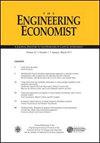Letter from the editor
IF 1
4区 经济学
Q4 BUSINESS
引用次数: 0
Abstract
This issue of The Engineering Economist contains four articles that contribute to engineering economics of energy and equipment management. I would like to thank all reviewers who contributed to the peer-review process as well as area editors Sarah Ryan (former TEE editor-in-chief), Karen Bursic, Roy Kwon, and Jo Min for their contributions to this issue. The issue begins with an article entitled “The Levelized Cost of Energy and Regulatory Uncertainty in Plant Lifetimes” written by David Rode and Paul Fischbeck. In many electric power applications, the life of an asset is uncertain and subject to regulatory disruptions. However, the asset life is typically assumed to be known with certainty when calculating the levelized cost of energy. The authors present a corrected version of the standard levelized cost of energy calculation and show its implications on multiple investment and policy applications. In “Economic Feasibility of the Investment in Residential Photovoltaics System Considering the Effects of Subsidy Policies: A Korean Case,” we publish a case study by Jingu Jang, Moonkyu Seo, Giwon Nam, and Deok-Joo Lee. Government policies seek to reduce the economic burden of household photovoltaic (PV) investments and thus promote solar energy to household users. The case study performs an economic feasibility analysis of investments in residential PV systems and considers the effects of several subsidy plan alternatives using the empirical data of Korea. The results show that the residential PV investment project would be economically viable without subsidy but the payback period exceeds ten years which may be too long to convince residential users to invest in a PV system. In the third article, “Optimal Replacement, Retrofit, and Management of a Fleet of Assets under Regulations of an Emissions Trading System,” authors Amir Rajabian and Sharareh Taghipour present a model for parallel replacement and improvement for a fleet of assets to minimize both the economic costs and greenhouse gas (GHG) emissions where the emissions are limited by an emissions trading system also known as cap-and-trade. Their model considers the possibility of both banking the emission allowances or trading them in the market and is applied to data from a fleet of excavators in Ontario, Canada. The model and the findings of this case study could help firms to manage emissions and costs of their assets in a jurisdiction regulated by cap-and-trade. In the last article, Kyoung-Taek Kim, Deok-Joo Lee, and Sung-Joon Park coauthor “Economic Service Life of Equipment under Uncertain Revenues: A Real Options Approach.” The purpose of this work is to develop a binomial lattice real option model for analyzing the optimal equipment replacement considering uncertain revenue conditions over time. The authors present a numerical example to illustrate how their discrete real option model can be used to create an optimal replacement decision lattice, calculate the economic service life of a piece of equipment, and conduct a sensitivity analysis to examine model performance under various aspects of revenue uncertainty. The Engineering Economist seeks submissions in a number of areas, including but not limited to capital investment analysis, financial risk management, cost estimation and accounting, cost of capital, design economics, economic decision analysis, engineering编辑来信
本期《工程经济学家》包含四篇对能源和设备管理工程经济学有贡献的文章。我要感谢所有参与同行评议过程的审稿人,以及区域编辑Sarah Ryan(前TEE主编)、Karen Bursic、Roy Kwon和Jo Min对本期的贡献。本期杂志的开篇是一篇题为《能源平准化成本和植物寿命中的监管不确定性》的文章,作者是David Rode和Paul Fischbeck。在许多电力应用中,资产的寿命是不确定的,并受到监管的干扰。然而,在计算能源平准化成本时,通常假设资产寿命是确定的。作者提出了标准平准化能源成本计算的修正版本,并展示了其对多种投资和政策应用的影响。在“考虑补贴政策影响的住宅光伏系统投资的经济可行性:一个韩国案例”中,我们发表了jinu Jang、Moonkyu Seo、Giwon Nam和Deok-Joo Lee的案例研究。政府的政策旨在减轻家庭光伏投资的经济负担,从而向家庭用户推广太阳能。本案例分析了住宅光伏系统投资的经济可行性,并利用韩国的经验数据考虑了几种补贴方案的影响。结果表明,在没有补贴的情况下,住宅光伏投资项目在经济上是可行的,但投资回收期超过10年,可能太长,无法说服住宅用户投资光伏系统。在第三篇文章《排放交易体系下资产群的最优置换、改造和管理》中,作者Amir Rajabian和Sharareh Taghipour提出了一个资产群平行置换和改进的模型,以最大限度地降低经济成本和温室气体(GHG)排放,其中排放受到排放交易体系(也称为限额与交易)的限制。他们的模型考虑了将排放配额存入银行或在市场上进行交易的可能性,并将其应用于加拿大安大略省一队挖掘机的数据。本案例研究的模型和结果可以帮助企业在受总量管制与交易监管的辖区内管理排放和资产成本。在上一篇文章中,Kyoung-Taek Kim, Deok-Joo Lee和Sung-Joon Park共同撰写了“不确定收入下设备的经济使用寿命:实物期权方法”。本文的目的是建立一个二项格实物期权模型,用于分析考虑不确定收入条件随时间变化的最优设备更换。作者给出了一个数值例子来说明他们的离散实物期权模型如何用于创建最优替换决策格,计算设备的经济使用寿命,并进行敏感性分析以检查模型在收入不确定性的各个方面的性能。《工程经济学家》在多个领域寻求投稿,包括但不限于资本投资分析、金融风险管理、成本估算与会计、资本成本、设计经济学、经济决策分析、工程学
本文章由计算机程序翻译,如有差异,请以英文原文为准。
求助全文
约1分钟内获得全文
求助全文
来源期刊

Engineering Economist
ENGINEERING, INDUSTRIAL-OPERATIONS RESEARCH & MANAGEMENT SCIENCE
CiteScore
2.00
自引率
0.00%
发文量
14
审稿时长
>12 weeks
期刊介绍:
The Engineering Economist is a refereed journal published jointly by the Engineering Economy Division of the American Society of Engineering Education (ASEE) and the Institute of Industrial and Systems Engineers (IISE). The journal publishes articles, case studies, surveys, and book and software reviews that represent original research, current practice, and teaching involving problems of capital investment.
The journal seeks submissions in a number of areas, including, but not limited to: capital investment analysis, financial risk management, cost estimation and accounting, cost of capital, design economics, economic decision analysis, engineering economy education, research and development, and the analysis of public policy when it is relevant to the economic investment decisions made by engineers and technology managers.
 求助内容:
求助内容: 应助结果提醒方式:
应助结果提醒方式:


